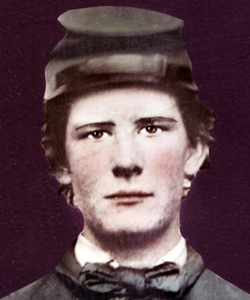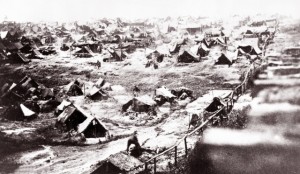My process began by browsing the Cumberland Civil War website. From prior research, I knew that the Carlisle Fencibles was one of the major volunteer companies from Carlisle. By using the search term “Carlisle Fencibles” on the Cumberland Civil War website, I found the article “The Carlisle Fencibles”. This article included a link to a member of that company, sixteen-year old John Taylor Cuddy.
Before settling on Cuddy, I visited the Dickinson College Archives. The archivist recommended the Charles Francis Himes collection. Himes was a former professor of natural science at Dickinson. The Himes collection included a few letters from the 1860’s, however, I concluded that gleaning useful information from this collection would be like finding a needle in a haystack.
After hitting this dead end, a trip was made to the Cumberland County Historical Society. By browsing the roster of the 36th Pennsylvania Co. A (Carlisle Fencibles), as listed on the American Civil War Research Database, I selected another likely subject, William Bratton. From prior research, I knew William was the son of John Bratton, the vehemently Democratic editor of the American Volunteer. Initially, John Bratton opposed the war while William enlisted as soon as he heard the news. The conflict of ideologies within one family seemed to be an excellent topic for research. However, after conducting a search for both men, the Bratton family, and the American Volunteer, in the CCHS database, this attempt was abandoned because of a lack of information.
At this point, John T. Cuddy’s letters were chosen for the manuscript collection section of this project. By looking at Cuddy’s enlistment statistics and the history of the 36th Pennsylvania via the American Civil War Research Database, I found that Cuddy enlisted on June 5, 1861 and served until May 5, 1864. On May 5 Cuddy was reported as missing during the Battle of the Wilderness and was brought to Andersonville Prison. Interestingly, the records from Andersonville Prison list Cuddy’s date of capture as May 6, 1864.
Located in Georgia, Andersonville was the unwilling home of Union prisoners for 14 months. During this time, 45,000 prisoners were sent to Andersonville, of which about 13,000 died. (James A. Percoco, The Space Beyond the Gates, and Andersonville Civil War Prison Historical Background, National Parks Service). Cuddy survived his stay at Andersonville but was transferred to Florence Prison in South Carolina. A letter from A. Noble to the Cuddy family indicates that Cuddy was not lucky a second time, “Cudy of Co. A 7th Regt PRvc Died at Florence South Carolina on the 29th day of September 1864” (John T. Cuddy Papers, Dickinson College Archives). The tragedy of John Cuddy’s story is acute. Cuddy was captured about one month before his regiment was mustered out of service on June 16, 1864. John T. Cuddy was one of 272 men captured from the 36th Pennsylvania Regiment (American Civil War Research Database).



Good narrative of a research trail with the usual fits and starts and occasional dead-ends. I’m not grading for prose but try to avoid passive voice. These posts demand some first-person. Also, if time allows, I would urge more work on the Bratton family. Any images? Any family letters? Can we put together a quick family tree and see if they relocated somewhere else and may have carried documents / artifacts with them? Your work on Cuddy is perfectly fine (and I hope you make a serious effort at creating a documentary video about him) but I can’t help but believe if we just put a little muscle into research the Brattons that we will find something good.